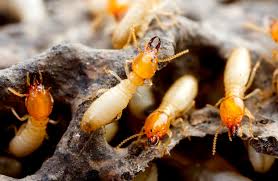Termite Control Organic Way Can Be Fun For Everyone
Termite species are best identified by their soldier termites, which gets got the most prominent features.
These termites are widely distributed throughout Victoria, and are responsible for more than 80 per cent of irreparable harm to buildings.
Coptotermes soldiers have brown, saber-like jaws. They measure 3.56.5 millimeters in length. When disturbed, these soldiers yank a rubbery substance from their pear-shaped heads.
Coptotermes build nests in trees (preferring eucalypts), stumps, under concrete flooring, in wall cavities or enclosed verandahs.
Some Ideas on Termite Control Orkin You Need To
These termites travel at least 50 metres from the colony using a series of underground tunnels to find food. Coptotermes acinaciformis send large numbers to new food sources and, therefore, respond strongly to lure. In contrast, Coptotermes frenchi explore widely for new food sources and feed lightly at points.
Nasutitermes exitiosus is common north of the Great Dividing Range. They construct dim, thin-walled mound nests between 30 cm and 75 cm above ground. These mounds are up to 1m in diameter.
This is species of termite, sometimes called dampwood termite. They are normally found nesting in large parts of timber (especially older trees) and are most common in wet, mountainous areas. They may, however, also be found in the foothills of Melbourne.
Porotermes tend to reside in smaller colonies than other species, and do not construct shelter tubes or travel far underground. They are more easily controlled than other species.
Rumored Buzz on Termite Control Paint
A colony of Schedorhinotermes will have two distinct sizes of soldiers, also called major and minor soldiers. Important soldiers grow around 5.6 mm long, while minor soldiers are only 3.6 mm long. The two kinds of soldier have mandibles.
Schedorhinotermes are destructive and relatively nomadic, rather than maintaining a fixed, central nest.

The soldiers of the species are around 4.75 mm long, with lengthy, dark jaws and parallel-sided heads.
Get This Report on Termite Control Paint
Heterotermes reside in small colonies that assault fence posts, wood flooring, and paling fences within a radius of the i loved this nest. They are commonly found because they feed on small timbers on the ground surface.
Dusts function to control termites because they ingest and disperse the insecticide among the colony during habitual grooming.
Insect growth-regulator dusts (such as Triflumuron) and non-repellent termiticides are the most powerful means of termite pest control to the human consumer.
Arsenic trioxide dust has been used since the 1930s to control termites, often with the addition of oxide or another colourant. However, arsenic trioxide is a poisonous, highly toxic elemental pesticide that does not degrade.
Baiting is most often the ideal way to kill an attacking colony when the main nest website cannot be found. Bait stations also let you collect samples of termites for species identification.
The Greatest Guide To Termite Control Organic Way
Bait stations consist of containers of cellulose materials like timber, paper or cellulose gel which are either buried in the ground near the building under assault or carefully placed inside near known damage.
Bait generally utilize slow-acting, non-detectable toxins so that the nearly whole colony can be poisoned before adverse impacts arise. Repellent termiticide formulations like those of pyrethroids are not as colony control agents. Care must be taken not to cross contaminate baits with even tiny residues of pesticides.
Baiting does not supply a barrier. The baits do not isolate the building as termites are able to access the structure. For long-term structural protection, barriers are favored.
Termite Control Organic Way for Beginners
Chemical barriers work by applying an unbroken boundary of pesticide around the outside of an infested structure. This creates a zone or band of soil the termites cannot cross. Creating an effective chemical barrier may involve trenching around the foundations of this construction, and injecting the chemical into the ground through holes drilled in concrete foundations. .
Termites work through the soil unaware they are picking up a chemical. This lessens the termite population and may destroy the colony.
Repellent chemicals, for example Bifenthrin, are commonly used as obstacles. Non-repellent termiticides, such as Imidacloprid and Fipronil, can be resilient where coverage is uncertain (for instance, where the chemical is injected through concrete).
Soil may you could check here also be treated with a chemical barrier prior to building construction. Bifenthrin is commonly employed for this purpose; Imidacloprid is often employed for the perimeter of a new structure.
Some Known Details About Termite Control Organic Way
This method isolates the termite colony from a building by creating an entire barrier around or beneath a buildings foundations that termites cannot cross.